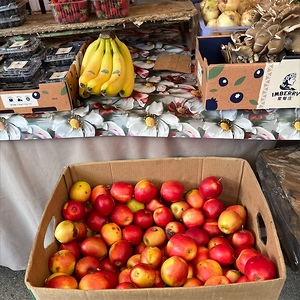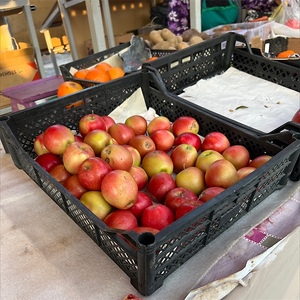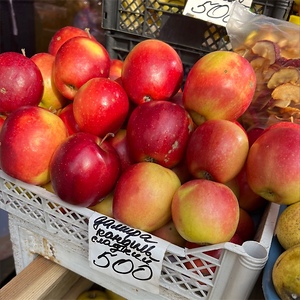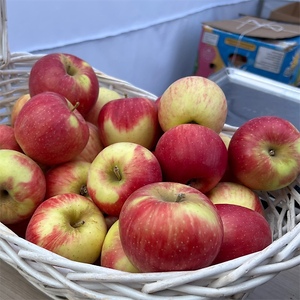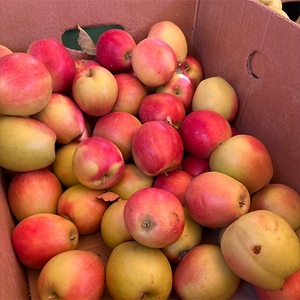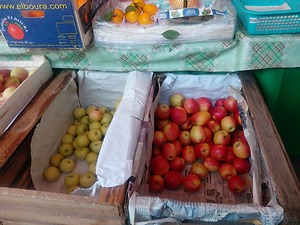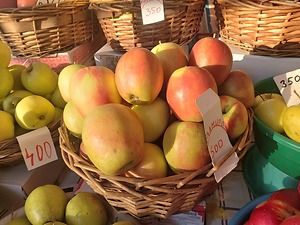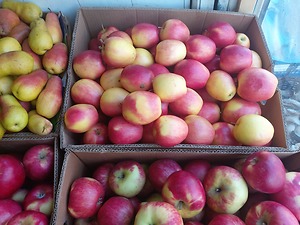


Damira Apples
Estimated Inventory, lb : 0
Description/Taste
Damira apples have a round, ovate, to conical shape, averaging nine centimeters in length, and are attached to very thin and slender, dark brown, fibrous stems. The skin is semi-smooth, waxy, and yellow-green, covered in multiple shades of red blushing and striping. Underneath the thin skin, the flesh is pale yellow to ivory, dense, and crisp, encasing a central core filled with tiny brown-black, oval seeds. When fresh, Damira apples are aromatic and juicy with a sweet, slightly acidic flavor.
Seasons/Availability
Damira apples are harvested in the fall and can be stored through late spring.
Current Facts
Damira apples, botanically classified as Malus domestica, are a winter variety that belongs to the Rosaceae family. The sweet-flavored apple was created at the Kazakh Research Institute of Fruit Growing and Viticulture and is believed to be a descendant of the aport apple, which was at one time one of the most famous varieties in Kazakhstan. Damira apples were created to have improved and productive commercial traits, and the trees have undergone extensive testing to ensure that quality growth characteristics and flavor are being met. In Kazakhstan, the variety is favored for its sweet and juicy nature and is commonly consumed fresh, out-of-hand.
Nutritional Value
Damira apples are a good source of vitamins A and C, which are antioxidants that can rebuild collagen within the body and can help boost the immune system. The apples also contain fiber, which can help regulate the digestive system, and contain some potassium, vitamin B6, manganese, and vitamin K.
Applications
Damira apples are best suited for fresh consumption as their sweet, lightly acidic flavor is showcased when consumed fresh, out-of-hand. The apples can be eaten whole as a snack, sliced and tossed into green salads, sliced into wedges and served with cheeses and spreads, diced into cereals, chopped into fruit salads, or pureed into apple sauce. Damira apples can also be utilized in desserts such as tarts, cobblers, pies, and cakes, baked whole with nuts in a sweet sauce, baked into bread and muffins, cooked into jams, roasted with meats, fried into fritters, or simmered into soups. In addition to fresh and cooked preparations, Damira apples can be dried or pickled for extended use. Damira apples pair well with honey, vanilla, cinnamon, potatoes, carrots, meats such as beef, pork, and veal, green onions, garlic, rice, raisins, and other dried fruits. The fresh apples will keep 2-4 months when stored in the refrigerator.
Ethnic/Cultural Info
In Kazakhstan, apples were once one of the most important agricultural commodities produced in the southern regions, consumed on a local level, and also highly exported into countries such as Russia. Historically, south Kazakhstan was filled with apple orchards brimming with many different varieties, including the famous aport, but after the fall of the Soviet Union, many of the orchards were lost. Aport apple trees were slow-growing, only producing fruit after 8 to 10 years, and with its irregular fruiting and growth habits, many of the orchards were removed to make room for urban development and expansion, causing aport apples to be pushed to the brink of extinction. Today entrepreneurs, private companies, and local farmers are seeking to revive the apple growing industry in southern Kazakhstan. While preserving some of the original varieties once grown, including the aport, many of the orchards are also cultivating newer varieties such as the Damira to compete with foreign imported varieties. Growers are using new technology such as grid sensors to track fruit falling patterns and monitor the orchards against thieves, implementing organic practices and packaging to meet changing health market demands, and utilizing online platforms to sell their crop.
Geography/History
Damira apples were created at the Kazakh Research Institute of Fruit Growing and Viticulture in Almaty, Kazakhstan. Developed from the aport variety, Damira apples were bred for their improved growing and storage characteristics. Currently, the variety can be found through local markets in Kazakhstan and may also be grown in home gardens as a specialty variety throughout central Asia.



